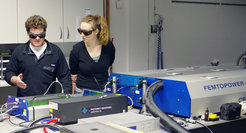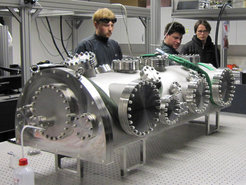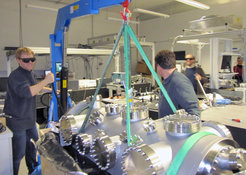
Table-top attosecond lasers

Our research using table-top attosecond laser systems, is focused on extending the range of available pump photon energies beyond the XUV to include the THz, and deep UV, for targeted excitation of complex, condensed matter systems. The key to this advance, is the utilization of single-cycle, NIR driving laser pulses, ideally suited for frequency conversion through nonlinear processes including three and four-wave mixing, optical rectification and through high-harmonic generation. Single-cycle, ~3 femtosecond NIR drive pulses – comparable in energy and duration to the shortest optical laser pulses available in the world – have now been demonstrated at the MPSD by tuning the temporal dispersion in an otherwise commercial multi-pass Ti:Sapphire amplifier system with the addition of customized chirped mirror multi-layer optics.
In conventional isolated-pulse attosecond spectroscopy, the XUV continuum, which supports attosecond laser pulses, is produced through high-harmonic generation in a gas target driven by a few-cycle NIR laser pulse. Our apparatus builds on existing technology by including a second high-pressure gas target. When driven in series by the same single-cycle NIR laser pulse the third and fifth harmonics (~5-10 eV photon energy) are generated in addition to the XUV continuum, resulting in a synchronized UV pulse that is shorter than the ~3 femtosecond drive pulse. It has also been reported that ultra-broadband THz radiation from below 1THz to above 10THz is simultaneously emitted from the gas target due to the inherent asymmetry of the electric field in a single-cycle driving laser pulse. We are currently working to characterize these additional sources and are building a beamline and surface-science experiment apparatus with the capability to utilize them all.

We are also working to adapt our attosecond laser source for high energy resolution spectroscopy that until now has not been possible. To achieve this, we will take advantage of the XUV continuum produced by high-harmonic generation with single-cycle drive pulses, which can be broader than 50eV in bandwidth and shifted in energy to beyond 130 eV. In established attosecond metrology techniques, the continuum, which contains frequency components above 100 eV due to the single-cycle drive pulse, is filtered by a multi-layer XUV mirror to produce attosecond laser pulses, the broader the reflected bandwidth the shorter the resultant pulse.
In the past, significant effort has been made to increase the bandwidth of these multi-layer mirrors to utilize more of the continuum and generate shorter attosecond pulses. Sub-100 attosecond pulses have been demonstrated using a multilayer that reflected ~28 eV of bandwidth. However, these pulses are of limited use when studying condensed matter systems where the relevant energy levels are separated by less than a single electron volt.

In our research, rather than striving for the highest time-resolution, temporal and spectral resolution will be balanced to suit the problem at hand. In tantalum disulfide, for example, where we would like to time the collapse of a Mott insulating state, the spacing between the associated energy levels is only ~1 eV. Therefore, we plan to probe this system with approximately 1 fs resolution such that distinct energy levels can be resolved while the fastest dynamics can still be captured.
We are currently working to develop and utilize narrowband multilayer XUV mirrors with bandwidths in the range of several hundred meV and variable central frequencies that span the spectrum of high-harmonic radiation. Here, the ultra broadband attosecond continuum will allow for flexibility in our choice of photon energy for experiments that demand both high time resolution as well as spectroscopic sensitivity.
All photos: © MPSD/J.M.Harms


